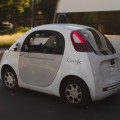As Google speeds ahead with plans to introduce self-driving cars onto the market, the company has developed a safety feature that’s quite unlike anything other. Meant to address pedestrian safety, if one of its cars gets into a crash with a person on foot, the feature involves a high-tech adhesive that acts very much like flypaper.
As science fiction movie-of-the-week as that might sound, Google is serious about the concept. So serious, in fact, the company has patented its idea. That patent request, granted in May, involves an adhesive layer on the front of the vehicle. This adhesive will bond “the pedestrian to the vehicle so that the pedestrian remains with the vehicle until it stops and is not thrown from the vehicle,” Google’s patent explains.
The point of the sticky paper is simple: to prevent pedestrians from being thrown to the ground. This, in turn, would help prevent often deadly secondary impacts with pavement or other surfaces.
Google’s concept even takes into account that driving with a substance similar to sticky paper could create quite a mess. With that in mind, the company plans to use an eggshell-type covering that will cover the adhesive. When the vehicle collides with an object, the shell will break, exposing the adhesive layer and securing the pedestrian.
You Might Also Enjoy: Google Car Accident | Self-Drives into Bus
The Google concept isn’t the first meant to address vehicle-pedestrian crashes, the Mirror pointed out. It is, however, an entirely new vision. Jaguar has some models that raise the car’s bonnet a few inches after impact to help soften blows. Volvo European models have outside airbags meant to help protect pedestrians from head injuries. Google is the first to attempt to prevent secondary impacts.
As innovative and forward-thinking as Google’s patent might be, not everyone is convinced the product will function as desired. Bryant Walker Smith, an affiliate scholar with Stanford Law School’s Center for Internet & Society, told The Mercury News the benefits would really depend on the situation. In some cases, the adhesive might actually lead to driver visual obstruction and a secondary crash.
Even so, Smith said Google deserves applause for considering more than driver and passenger safety.
“The idea that cars should be safe for people other than the ones in them is the next generation of automotive safety,” Walker said.
Just how soon Google’s self-driving car will enter the mass market remains unclear. The company, however, announced plans in late May to open a 53,000-square-foot development center in Novi, Mich. It also has inked a deal with Fiat Chrysler Automobiles to turn about 100 2017 Chrysler Pacifica hybrid minivans into self-driving vehicles, the Detroit Free Press reported.






